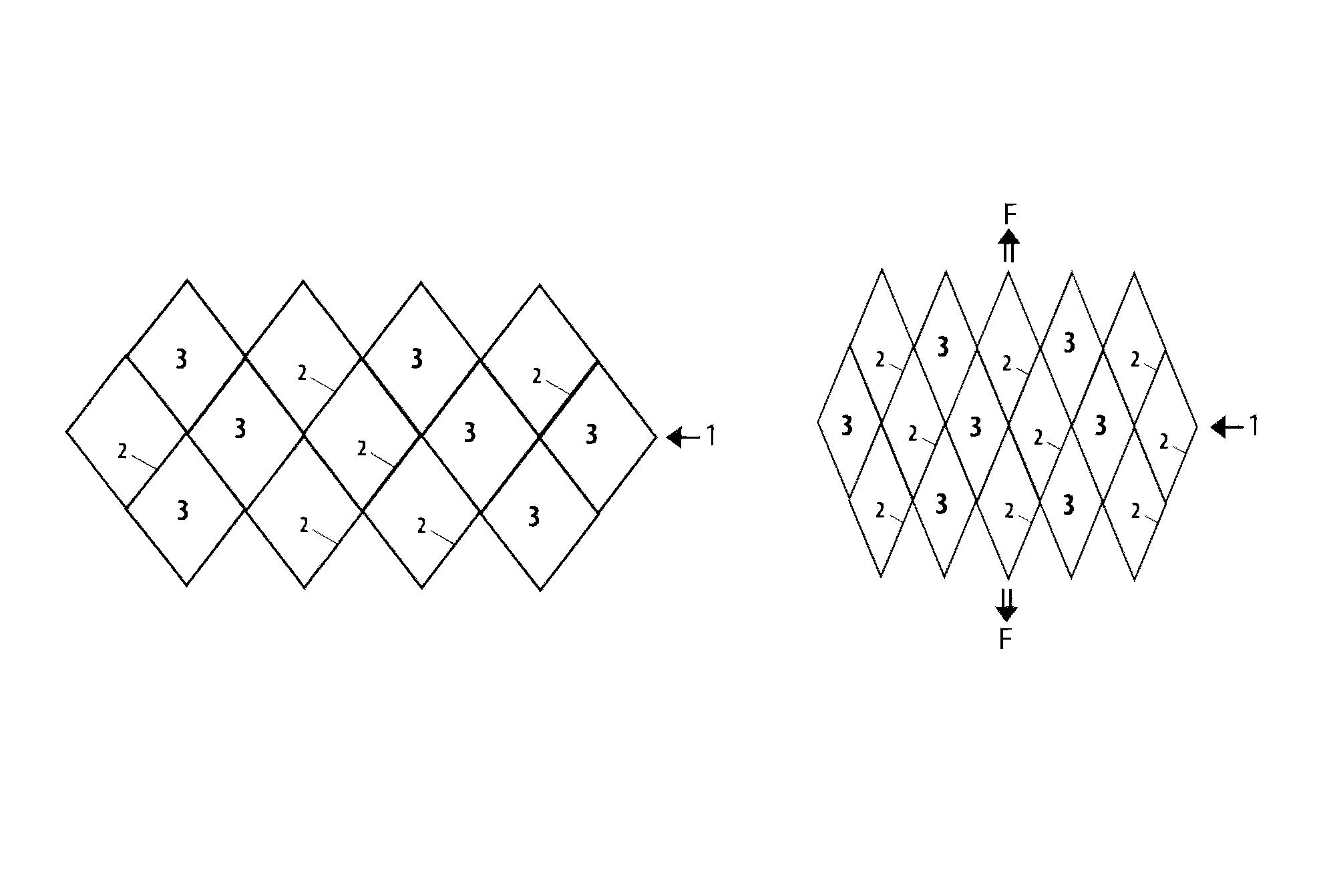Elastically deformable and resorbable medical mesh implant
a polymer mesh and resorbable technology, applied in the field of resorbable polymeric mesh implants, can solve the problems of meshes not showing a true elastic behavior and unsatisfactory mechanical characteristics for some medical applications
- Summary
- Abstract
- Description
- Claims
- Application Information
AI Technical Summary
Benefits of technology
Problems solved by technology
Method used
Image
Examples
first embodiment
[0019]FIG. 2a and FIG. 2b illustrate a mesh implant 11 according to the present invention. The mesh 11 comprises a first set of fibers 12, which are arranged in a first knit pattern such that a number of apertures 13 are formed in the mesh 11. The fibers 12 are preferably made from a resorbable polymer. Within an aperture 13, a fiber 14 is arranged, such that the fiber 14 traverses the aperture 13 and is connected to two points on the perimeter of the aperture 13. In this embodiment, each individual fiber 14 is connected to the corresponding points on the perimeter of an aperture 13 such that all of the fibers 14 extend in the same direction of the mesh implant 11, which direction may be denoted a first direction of the mesh implant 11. The fibers 14 are made from an elastic and preferably resorbable polymer. In FIG. 2a, the mesh 11 is shown in an initial or relaxed state, i.e. the mesh 11 is not subjected to any external forces. Following the same reasoning as in conjunction with t...
second embodiment
[0021]As described above, the mesh 11 comprises elastic fibers 14, which are arranged in only one direction of the mesh 11. Other arrangements are also possible, and FIG. 3 illustrates a mesh implant 21 according to the present invention. The mesh 21 comprises a first set of fibers 22, which are arranged in a first knit pattern such that a number of apertures 23 are formed in the mesh 21. The fibers 22 are preferably made from a resorbable polymer. Within a first subset of the apertures 23, an elastic fiber 24 is arranged such that the fiber 24 traverses the aperture 23 in a first direction and is connected to two points on the perimeter of the aperture 23, and within a second subset of the apertures 23, an elastic fiber 24′ is arranged such that the fiber 24′ traverses the aperture 23 in a second direction and is connected to two points on the perimeter of the aperture 23.
[0022]In the embodiment shown in FIG. 3, the first direction coincides with the vertical direction of the mesh ...
third embodiment
[0024]In the embodiments described above in conjunction with FIGS. 2a-b and FIG. 3, respectively, an aperture contains at most one elastic fiber. It is however possible that an individual aperture in a mesh contains more than one elastic fiber, e.g. two fibers arranged two different directions. FIG. 4 illustrates a mesh implant 31 according to the present invention. The mesh 31 comprises a first set of fibers 32, which are arranged in a first knit pattern such that a number of apertures 33 are formed in the mesh 31. The fibers 32 are preferably made from a resorbable polymer. Within an aperture 33, a first elastic fiber 34 is arranged such that the fiber 34 traverses the aperture 33 in a first direction and is connected to two points on the perimeter of the aperture 33. Within the same aperture 33, a second elastic fiber 34′ is arranged such that the fiber 34′ traverses the aperture 33 in a second direction and is connected to two points on the perimeter of the aperture 33. In this ...
PUM
 Login to View More
Login to View More Abstract
Description
Claims
Application Information
 Login to View More
Login to View More - R&D
- Intellectual Property
- Life Sciences
- Materials
- Tech Scout
- Unparalleled Data Quality
- Higher Quality Content
- 60% Fewer Hallucinations
Browse by: Latest US Patents, China's latest patents, Technical Efficacy Thesaurus, Application Domain, Technology Topic, Popular Technical Reports.
© 2025 PatSnap. All rights reserved.Legal|Privacy policy|Modern Slavery Act Transparency Statement|Sitemap|About US| Contact US: help@patsnap.com


